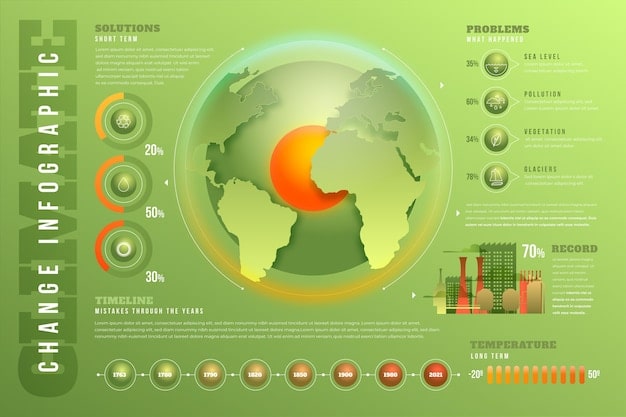New environmental regulations and 2030 carbon emissions

The effectiveness of new environmental regulations in significantly reducing carbon emissions by 2030 remains a complex and debated topic, with outcomes heavily dependent on political will, technological advancements, and swift global implementation.
The global community grapples with one of humanity’s most pressing challenges: climate change. As nations worldwide introduce new environmental regulations, a critical question emerges: Will the new environmental regulations effectively reduce carbon emissions by 2030?
The Ambitious Landscape of Global Climate Pledges
The world is at a pivotal juncture concerning climate action. Governments and international bodies have intensified their commitments to combat global warming, primarily through a web of new environmental regulations. These regulations are not uniform; they vary significantly in scope, enforceability, and ambition across different nations and blocs.
For instance, the European Union has been a frontrunner, spearheading initiatives like the European Green Deal, which aims to make Europe climate-neutral by 2050, with an interim target of reducing net greenhouse gas emissions by at least 55% by 2030, compared to 1990 levels. This ambitious target necessitates a radical overhaul of various sectors, from energy production to transportation and agriculture. Conversely, other major emitters, while acknowledging the climate crisis, have adopted more gradual or less stringent approaches, often balancing environmental goals with economic development imperatives.
Diverse Regulatory Frameworks
The regulatory frameworks typically encompass a range of policy tools:
- Carbon Pricing Mechanisms: These include carbon taxes or cap-and-trade systems, aiming to make carbon-intensive activities more expensive.
- Renewable Energy Mandates: Governments set targets for the percentage of electricity to be generated from renewable sources.
- Energy Efficiency Standards: Regulations improve the energy performance of buildings, appliances, and industrial processes.
- Vehicle Emission Standards: Stricter rules are applied to vehicle fleets, promoting electric vehicles and discouraging internal combustion engines.
The effectiveness of these regulations hinges on their design and implementation. A critical aspect is the stringency of the targets and the mechanisms for enforcement. Loopholes, exemptions, or insufficient penalties can undermine even the most well-intended policies. Furthermore, the political will to sustain these regulations amidst economic headwinds or industrial lobbying is a persistent challenge.
The collective impact of these diverse national and regional efforts will determine the global trajectory of carbon emissions by 2030. While some regions are moving swiftly, others lag, creating a patchwork of progress. This disparity underscores the complexity of achieving a unified and effective global reduction in emissions. The global community’s ability to reduce carbon emissions by 2030 is less about the existence of new regulations and more about their teeth and reach, alongside the capacity and willingness of nations to genuinely adhere to their pledges.
Key Mechanisms and Their Potential Impact
Understanding the potential impact of new environmental regulations on carbon emissions requires a closer look at the specific mechanisms being deployed. These diverse tools aim to steer industries and consumers towards less carbon-intensive practices, but their efficacy varies depending on context and implementation rigor.
One of the most widely discussed mechanisms is carbon pricing. This can take the form of a carbon tax, directly imposing a levy on carbon dioxide emissions, or an emissions trading system (ETS), also known as cap-and-trade. In an ETS, a cap is set on the total amount of certain greenhouse gases that can be emitted by specific sectors. Companies receive or buy emission allowances, which they can trade with one another. This creates a market price for carbon, incentivizing businesses to reduce their emissions to save costs or profit from selling excess allowances. The EU ETS, for instance, has demonstrated its capability to drive emissions down in covered sectors, albeit with fluctuating carbon prices and the need for regular adjustments to the cap.
Driving Decarbonization Through Policy
Beyond carbon pricing, direct regulatory mandates play a crucial role. These include targets for renewable energy deployment, such as requiring a certain percentage of electricity to come from solar, wind, or hydro sources. Many countries have set ambitious renewable portfolio standards, which have significantly bolstered investment in clean energy infrastructure and reduced reliance on fossil fuels for power generation. These mandates create a stable market for renewable technologies, driving down their costs and accelerating their adoption.
- Energy Efficiency Standards: Regulations on building codes, appliances, and industrial processes compel improvements in energy usage.
- Vehicle Emission Standards: Increasingly stringent rules for automobiles push manufacturers towards electric vehicles and more fuel-efficient internal combustion engines.
- Industrial Process Emissions: Regulations target emissions from heavy industries like steel, cement, and chemicals, often encouraging the adoption of carbon capture and storage (CCS) or hydrogen technologies.
The impact of these mechanisms is multifaceted. They can stimulate innovation in clean technologies, create green jobs, and improve public health by reducing air pollution. However, challenges persist. Carbon prices can be politically contentious and may face resistance from industries concerned about competitiveness. Renewable energy mandates require significant grid modernization and can face NIMBY (Not In My Backyard) opposition for new infrastructure. Furthermore, the global nature of carbon emissions means that isolated national efforts may be undermined if other major emitters do not adopt similar stringent policies, leading to concerns about carbon leakage.
Ultimately, the collective success of these mechanisms by 2030 hinges on the scale of their application, the consistency of enforcement, and the ability of governments to navigate socio-economic implications. An integrated policy approach, combining market-based instruments with direct regulations and supportive fiscal incentives, is often seen as the most effective path towards significant carbon emission reductions.
Challenges and Hurdles to Effective Implementation
While the ambition behind new environmental regulations is commendable, their effective implementation faces a myriad of challenges and hurdles. These obstacles are often complex, intertwining economic, political, social, and technological dimensions, making the path to significant carbon emission reductions by 2030 far from straightforward.
One primary challenge is political commitment and stability. Environmental policies often require long-term vision and consistent support, transcending political cycles. Changes in government can lead to policy reversals, weakening or abandoning existing regulations. This instability creates uncertainty for businesses and investors, hindering the necessary large-scale investments in green technologies and infrastructure. Lobbying from industries heavily reliant on fossil fuels also exerts significant pressure, often seeking exemptions or watered-down regulations.
Overcoming Obstacles for Carbon Reduction
The economic implications of transitioning away from fossil fuels present another significant hurdle. Implementing new regulations can initially increase costs for businesses and consumers, potentially leading to job losses in traditional sectors and concerns about economic competitiveness. Governments face the delicate balancing act of promoting environmental sustainability without unduly burdening industries or disproportionately affecting vulnerable populations. The concept of a “just transition” – ensuring that workers and communities dependent on fossil fuel industries are supported during the shift – is critical but challenging to execute effectively.
- Technological Readiness: While many green technologies exist, some, like large-scale carbon capture or green hydrogen production, are still in nascent stages or require further cost reductions to be widely viable.
- Infrastructure Gaps: The transition requires extensive new infrastructure, including smart grids for renewable energy, charging stations for electric vehicles, and revamped industrial processes.
- Global Equity and Cooperation: Developing nations often argue for their right to economic growth and require financial and technological support from developed nations to implement stringent environmental policies without hindering their development.
- Public Acceptance: Significant lifestyle changes, such as shifts in transportation or energy consumption habits, may be necessary, and gaining widespread public acceptance can be difficult.

Regulatory complexity itself can be an impediment. Crafting regulations that are comprehensive, clear, and enforceable across diverse sectors and local contexts is a monumental task. Overlapping jurisdictions, bureaucratic delays, and a lack of harmonized international standards can further complicate implementation. Furthermore, the sheer scale of the transformation required by 2030 means that even well-designed policies may not yield results quickly enough if not executed with unprecedented speed and coordination.
Addressing these challenges requires a multi-pronged approach: fostering strong political will, providing targeted economic incentives, investing heavily in research and development for emerging technologies, building robust infrastructure, and ensuring equitable global cooperation. The success of new environmental regulations in meeting 2030 targets will ultimately depend on how effectively these complex hurdles are navigated.
Technological Advancements: A Game Changer?
The trajectory of carbon emissions reduction by 2030 is inexorably linked to the pace and scale of technological advancements. While new environmental regulations set the framework and provide incentives, it is often innovation that provides the means to achieve ambitious targets. Many experts describe technology as a potential game changer, capable of accelerating decarbonization efforts beyond what traditional policy instruments alone could achieve.
The most prominent technological advancements are seen in the renewable energy sector. Solar photovoltaics and wind power, once niche technologies, have seen dramatic cost reductions and efficiency improvements, making them economically competitive with, and in many regions cheaper than, fossil fuels. This rapid evolution means that the deployment targets set by regulations are becoming increasingly achievable, and in some cases, are being surpassed. Battery storage technology, crucial for integrating intermittent renewables into the grid, is also advancing rapidly, offering solutions to grid stability challenges.
Innovations Driving Sustainability
Beyond renewables, several other technological areas hold significant promise:
- Electric Vehicle (EV) Technology: Improvements in battery range, charging infrastructure, and cost reductions are rapidly accelerating EV adoption, drastically cutting transport emissions.
- Carbon Capture, Utilization, and Storage (CCUS): While still costly and limited in deployment, breakthroughs in CCUS could enable decarbonization of hard-to-abate industrial sectors and even direct air capture.
- Green Hydrogen: Producing hydrogen using renewable electricity could offer a clean fuel for heavy industry, shipping, and aviation, sectors difficult to electrify directly.
- Energy Efficiency Solutions: Smart building technologies, advanced insulation materials, and industrial process optimization tools continually reduce energy consumption across sectors.
However, the existence of these technologies does not guarantee their widespread deployment by 2030. Challenges remain in scaling up production, reducing costs further, and integrating them into existing systems. For instance, while green hydrogen shows immense promise, significant investment in renewable electricity generation and new infrastructure for hydrogen production, transport, and storage is needed. Similarly, while EVs are gaining traction, the global charging infrastructure still needs substantial expansion to support universal adoption. These technologies often require supportive policies – subsidies, R&D funding, and regulatory certainty – to bridge the gap from laboratory to widespread commercial application.
Moreover, unexpected innovations or synergistic advancements could emerge, further accelerating the transition. Artificial intelligence and machine learning, for example, are being leveraged to optimize energy grids, predict renewable output more accurately, and improve the efficiency of industrial processes. The question then becomes how effectively and how quickly these technological leaps can be deployed and scaled globally, making them truly transformative in the push to significantly reduce carbon emissions by 2030. The interplay between regulatory push and technological innovation will be key.
Economic Implications and Green Growth Opportunities
The implementation of new environmental regulations
to reduce carbon emissions by 2030 is often perceived through the lens of economic cost. However, a more nuanced perspective reveals that while there are certainly expenses associated with transitioning to a low-carbon economy, there are also substantial economic implications and significant green growth opportunities. This paradigm shift suggests that climate action is not solely an environmental imperative but also a pathway for economic modernization and competitiveness.
Initially, regulations that impose costs on carbon emissions may lead to concerns about competitiveness for industries, particularly those in energy-intensive sectors. These concerns are valid and often necessitate careful policy design, such as border carbon adjustments, to prevent carbon leakage—where industries relocate to countries with less stringent environmental regulations. However, these initial costs are increasingly outweighed by the long-term benefits of green innovation. Investment in renewable energy, for example, has created millions of jobs globally in manufacturing, installation, and maintenance, often referred to as “green jobs.”
Investing in a Sustainable Future
The shift towards a green economy stimulates innovation across various sectors. Companies that invest in developing and deploying low-carbon technologies gain a competitive edge in emerging global markets. This drive for innovation extends beyond energy to areas like sustainable agriculture, circular economy models, and efficient resource management. Countries that lead in these areas stand to gain significant economic advantages, becoming exporters of green technologies and expertise.
- Job Creation: Growth in renewable energy, energy efficiency, and sustainable infrastructure sectors.
- Resource Efficiency: Regulations encourage industries to use resources more efficiently, reducing waste and raw material costs.
- Reduced Externalities: Fewer health costs associated with air pollution and reduced long-term costs of climate change impacts.
- Investment Attraction: Countries with clear, stable environmental policies attract green investments and capital.

Furthermore, the energy transition can enhance national energy security by reducing reliance on volatile fossil fuel markets. Domestic renewable energy sources provide a more stable and predictable energy supply, lessening vulnerability to geopolitical tensions and price shocks. This localized energy production often leads to significant cost savings in the long run, as the initial capital investment for renewables is offset by zero fuel costs.
However, realizing these green growth opportunities requires strategic planning and robust policy support. Governments must provide clear signals, stable regulatory frameworks, and financial incentives to de-risk investments in new technologies. Public-private partnerships are crucial in mobilizing the massive capital required for infrastructure development. While challenges like retraining workers from traditional industries and ensuring equitable distribution of benefits remain, the overall economic narrative is shifting: strong environmental regulations, far from being solely a cost, are increasingly recognized as a catalyst for sustainable economic growth and long-term prosperity. The pathway to 2030 will demonstrate how effectively nations can leverage these opportunities.
International Cooperation and Climate Justice
The effectiveness of new environmental regulations in reducing carbon emissions by 2030 cannot be assessed in isolation; it critically hinges on the degree of international cooperation and the principles of climate justice. Addressing climate change is a global endeavor, transcending national borders, as emissions from one country affect all others. Therefore, coordinated global action is indispensable for achieving meaningful and lasting emission reductions.
International agreements, such as the Paris Agreement, provide the foundational framework for cooperation, setting shared goals and encouraging nations to submit Nationally Determined Contributions (NDCs). These agreements facilitate knowledge sharing, technology transfer, and financial flows, particularly from developed to developing countries, to support their climate mitigation and adaptation efforts. Without such collaborative mechanisms, there is a risk of fragmented efforts, carbon leakage, and an inability to collectively address the scale of the climate crisis. The 2030 target, in particular, requires an unprecedented level of international alignment on policy ambition and implementation.
Global Collaboration for a Future
The concept of climate justice is central to effective international cooperation. It recognizes that those who have historically contributed the least to climate change, largely developing nations, are often the most vulnerable to its impacts. Furthermore, these nations often lack the financial and technological capacity to transition rapidly to low-carbon economies without assistance. Climate justice calls for:
- Fair Burden Sharing: Developed nations, historically responsible for the majority of greenhouse gas emissions, should take the lead in emissions reduction and provide financial support.
- Technology Transfer: Facilitating the transfer of clean energy and sustainable technologies to developing countries at affordable rates.
- Capacity Building: Supporting developing nations in building the expertise and infrastructure needed for climate action.
- Addressing Loss and Damage: Providing financial and other forms of support to countries experiencing unavoidable climate impacts.
Lack of equitable progress on these fronts can undermine trust and hinder broader cooperation. If developing nations perceive regulations as unilateral burdens, pushed by countries that benefited from carbon-intensive development for decades, they may be less willing to comply with stringent targets. Geopolitical tensions, trade disputes related to environmental standards, and differing national priorities further complicate the path to unified action.
Despite these challenges, there are encouraging signs of deepening cooperation, from multilateral initiatives to bilateral agreements focused on specific sectors or technologies. Financial mechanisms, such as the Green Climate Fund, aim to channel resources towards climate action in developing countries. Progress toward 2030 will largely be determined by the ability of the international community to strengthen these cooperative frameworks, close funding gaps, ensure equitable transitions, and build collective ambition. The success of new environmental regulations within national borders is therefore intrinsically linked to the health and equity of global climate governance.
The 2030 Horizon: Outlook and Projections
As the target year of 2030 rapidly approaches, the outlook and projections for whether new environmental regulations will effectively reduce carbon emissions are a mix of cautious optimism and stark warnings. Scientific consensus, models from international organizations, and the pace of current policy implementation offer varying but critical insights into the likely trajectory of global carbon emissions.
Current projections from bodies like the UN Environment Programme (UNEP) and the Intergovernmental Panel on Climate Change (IPCC) indicate that while existing pledges and policies represent significant progress compared to pre-Paris Agreement scenarios, they are still insufficient to limit global warming to 1.5°C or even well below 2°C, the ideal targets to avert the most catastrophic impacts of climate change. The gap between current policies and the trajectory needed for a 1.5°C world, often called the “emissions gap” or “ambition gap,” remains substantial. This suggests that while new environmental regulations are having an effect, they are not yet collectively stringent or widespread enough to achieve the necessary deep cuts by 2030.
Forecasting Emissions Reductions
However, the narrative is not entirely bleak. There is accelerated deployment of renewable energy, rapid technological advancements, and increasing corporate and subnational climate action. These factors suggest that some regions and sectors may significantly outperform their initial projections. For example:
- Renewable Energy Uptake: The unprecedented growth in solar and wind power, coupled with falling costs, may lead to faster decarbonization of electricity grids than previously anticipated.
- Electric Vehicle Adoption: Surging sales of EVs in major markets suggest that transport emissions could peak and decline sooner than older models predicted.
- Policy Innovation: The continuous evolution of environmental policy, including more sophisticated carbon markets and green finance initiatives, could accelerate change.
The critical factor for truly effective reductions by 2030 is the implementation gap – the difference between countries’ stated climate goals (NDCs) and the actual policies and actions taken to achieve them. Many nations still need to translate their aspirations into concrete, enforceable regulations that drive real-world change. Furthermore, a significant portion of the projected emissions reductions relies on future technologies and unprecedented levels of international cooperation, which are not guaranteed. The geopolitical landscape and potential economic downturns could also divert attention and resources away from climate action.
In essence, the 2030 horizon presents a dual reality: significant progress is being made, largely thanks to new regulations and technological innovation, but the pace and scale are still insufficient to meet the most ambitious climate goals. The next few years will be crucial in determining whether the momentum built by new environmental regulations can be amplified and universally adopted to place the world firmly on a path to a sustainable future, or if further, more drastic measures will be required beyond 2030 to mitigate the worst effects of climate change.
| Key Aspect | Brief Description |
|---|---|
| 🎯 Policy Ambition | Regulations vary globally; EU leads, others are more gradual, impacting collective efficacy. |
| ⚙️ Key Mechanisms | Carbon pricing, renewable mandates, and efficiency standards push decarbonization. |
| hurdles | Political instability, economic costs, technological readiness, and public acceptance are major challenges. |
| 💡 Tech Impact | Renewables, EVs, and CCUS offer massive potential but need scale-up and integration. |
Frequently Asked Questions About 2030 Carbon Regulations
▼
The primary goals of new environmental regulations by 2030 are to significantly reduce greenhouse gas emissions, particularly carbon dioxide, to mitigate climate change. These regulations aim to accelerate the transition to renewable energy, improve energy efficiency across sectors, promote sustainable practices, and align national policies with international climate commitments like the Paris Agreement’s 1.5°C target.
▼
Carbon pricing mechanisms, such as carbon taxes or cap-and-trade systems, make emitting carbon more expensive. By attaching a cost to carbon, these mechanisms incentivize businesses and consumers to reduce their carbon footprint, invest in cleaner technologies, and shift towards less carbon-intensive practices. This market-based approach creates economic signals that drive decarbonization across various industries and energy sectors.
▼
Several challenges could hinder the effectiveness of new regulations, including political instability that leads to policy reversals, economic concerns over competitiveness and transition costs, and resistance from established fossil fuel industries. Furthermore, the need for rapid technological deployment, large-scale infrastructure development, and ensuring global equity and cooperation also pose significant hurdles to achieving 2030 targets.
▼
While technological advancements, especially in renewable energy, electric vehicles, and carbon capture, are crucial enablers, they alone cannot solve the carbon emission problem. Policies and regulations are essential to create the market conditions, incentives, and frameworks that accelerate the adoption and scaling of these technologies. Technology and policy must work in tandem; robust regulations drive innovation and deployment, making ambitious emission reduction targets achievable.
▼
International cooperation is paramount because climate change is a global problem that no single nation can solve alone. Coordinated efforts, shared responsibilities, and financial and technological support to developing nations ensure a unified and equitable approach. International agreements facilitate knowledge transfer and prevent “carbon leakage,” where emissions simply shift to countries with laxer regulations, thereby undermining overall global efforts to meet emission targets by 2030.
Conclusion
The inquiry into whether new environmental regulations will effectively reduce carbon emissions by 2030 reveals a complex and dynamic landscape. While ambitious regulations are being enacted globally, driven by a growing scientific consensus and urgent climate imperatives, their ultimate success remains contingent on a confluence of factors: the unwavering political will to implement and enforce these policies, the rapid scaling and widespread adoption of transformative technologies, and an unprecedented degree of international collaboration and commitment to climate justice. The journey to 2030 is characterized by both significant progress and formidable challenges. While current projections indicate that more aggressive measures are likely needed to align with the 1.5°C target, the momentum generated by new regulations, coupled with technological innovation and growing public awareness, offers a realistic pathway towards substantial, albeit not yet sufficient, carbon emission reductions. The coming years will be crucial in determining if the promises of today translate into a materially decarbonized world by the end of the decade.





